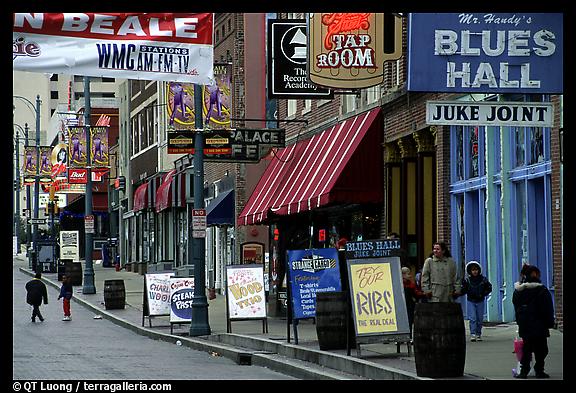

  |
|
last modified: Sunday, December 18, 2005 9:19 PM |
|
Incorporating the Untapped: The Case of Memphis Tennessee |
|
Elizabeth Delgado |
lizzyd@umich.edu |
According to Castells and Portes (1989), the informal economy constitutes licit forms of work outside the regulated, or formal, economy, where individuals are working in an unregulated and non-state sanctioned environment. Typically individuals working in the informal economy describe either not reporting or underreporting income on tax returns. In addition, other forms of regulation are often evaded, including applying for permits, and buying insurance as stipulated by local, state and other regulatory agencies.
Traditional literature on the informal economy
has typically focused on its activity and impacts on developing countries. There
is little written about its presence in highly developed countries, such
as the
1) Significant unreported income
· Earnings are underreported when households in the area are working outside the formal employment realm, many times being paid ‘under the table.’ (i.e. construction, farm work, housekeeping, landscaping, etc where monetary compensation for labor is made in cash with no formal way of reporting such income in taxes, as well as no way for the employer to report such salaries- many times extremely low compared to minimum wage);
· Retail sales are underreported in several important ways that distort the indicators that retailers use. These include hiring workers not on a payroll (i.e. with many business closely tied with social networks, hiring someone within the family or close friend is not unusual);
2) Under-count of the population
· Inner
cities have been traditionally been noted as places where there is a
disparate undercount of the population, especially among low income, transient,
and racial minorities. But when it comes to Latinos, many underreport
or do not report at all the total number of people within household because
of documentation status and a differential view of household structure
than the typical
As a result many healthy and vibrant inner
city communities have not been able to demonstrate in their market analysis
the full economic potential of their area. Most developers rely mostly
on detailed maps of population density, homeownership, household incomes,
automobile ownership, and crime statistics from commercial firms in choosing
an area for development (Pawasarat et al, 2001). The
disparity of what is actually experienced in the given areas with what
is being found on the U.S. Census and economic activity has been the main
goal that many working in inner cities have started to take note on maximizing
the economic activity of these areas. Recent developments and population
shifts have highlighted the importance of the analysis of the informal
economy in the
There have been various reports about organizations
attempting to account for un-recording of economic activity, which encompasses
both the un-reporting of income and employment as well as the undercounting
of the population. The case study below is an
example in
Memphis, Tennessee

The University of Memphis Center for the Research on Women (CROW) has been able to document the social, economic, and demographic impact of the local Latino population in the region. Within the scope of their research are estimates of the total economic impact of Latino workers on the regional economy. They argue that given the buoyant labor market in the U.S., Latino immigrant workers have tended not to displace local workers, but rather fuel economic growth in most regional economies. [2] CROW focuses not on the informal economy but on the economic impact of Latinos. This assumes that most Latinos in the area participate in some form of such activities.
 They use the context of a changing population
in Memphis, with a picture of the new Latino immigrant population
in Memphis. This is exemplified by a population that is younger, increasingly
skilled, and more highly educated than those who arrived in previous
decades, along with an increase of immigration by women and children. This
change in the characteristics in a population characterized by being low-skilled,
low-educational levels, and mostly men, and replaced by families moved
much of the immigration policy suggestions towards permanent residency. But
unlike predictions of high un-documentation among Hispanics in Tennessee,
over 90% are U.S. citizens. This may be due to longevity in the area,
where families have lived and worked in Tennessee for one, two or even
several generations. Yet this does not discount the idea of invisibility,
where population and income of Latinos are underreported and undercounted
leading to an underestimation of the spending potential in an area. Additionally,
CROW indicates that Latinos initially found employment in agriculture
in Tennessee and in the construction industry, and have moved to other
sectors with
They use the context of a changing population
in Memphis, with a picture of the new Latino immigrant population
in Memphis. This is exemplified by a population that is younger, increasingly
skilled, and more highly educated than those who arrived in previous
decades, along with an increase of immigration by women and children. This
change in the characteristics in a population characterized by being low-skilled,
low-educational levels, and mostly men, and replaced by families moved
much of the immigration policy suggestions towards permanent residency. But
unlike predictions of high un-documentation among Hispanics in Tennessee,
over 90% are U.S. citizens. This may be due to longevity in the area,
where families have lived and worked in Tennessee for one, two or even
several generations. Yet this does not discount the idea of invisibility,
where population and income of Latinos are underreported and undercounted
leading to an underestimation of the spending potential in an area. Additionally,
CROW indicates that Latinos initially found employment in agriculture
in Tennessee and in the construction industry, and have moved to other
sectors with

CROW comes to the conclusion that Latinos workers in the Memphis area have a total economic impact of $1,020,000 and 35,972 jobs. They go on to document that Latino workers earn less than $20,000/ yr, with one unusual characteristic for low wage workers- they tend to have very high savings rate- which is almost 30%, sending over 2/3 of these savings back to a family in Mexico or another Latin American country. Additionally, they state that Latinos in Memphis spent $359.6 million in the local economy. They also provide a breakdown of consumer expenditures and savings of Latinos workers in the Memphis area.
The methodology used by researchers in this study were not specified in the paper, but Professor David E. Ciscel, an economist at the University of Memphis and primary researcher in this study recommends that the Latino population be treated as new business coming into a city. This method is intended to measure the economic activity of the area the same way the cities are able to measure the impact of a Paper facility, for example. Professor Ciscel expanded on the methodology stating that they “estimated the number of jobs, the kinds of occupations, and the wages from those occupations -- usually available for every MSA from the State Department of Labor web site (and then we had gross income or total wages). Then we did an estimate on the spending patterns -- it was very helpful to have an anthropologist at this point who had done a lot of work in the Latino community. At this stage, it was just applying the RIMS II multipliers just like I had just in industrial development studies. Easy, quick, and the business community believes you since they use these methods ALL the time [3] .” RIMS II multipliers are widely used by public and private sector economists to estimate the regional impact--on output, earnings, and employment--of economic events, such as a new airport or the construction of a sports facility.
This case study illustrates one method that has worked in Memphis, Tennessee where economic developers have been able provide an estimate for the impact that the informal activity is currently having in this region. Other case studies have been able to document and estimate the un-recorded economic activity through other methods, along with different focus.
Resources:
Mendoza, Marcela, et al. “Latinos Immigrants in Memphis, Tennessee: Their Local Economic Impact.” University of Memphis, Center for the Research of Women. January 2001.
http://cas.memphis.edu/isc/crow/crowlatino.pdf
Pawasarat, John and Quinn, Lois M. “Exposing Urban Legends: The Real Purchasing Power of Central City Neighborhoods.” The Brookings Institution. June 2001.
Other Resources:
Social Compact
Michael Porter and the Initiative for a Competitive Inner City
The Pew Hispanic Center Report. “The New Latino South: The Context and Consequences of Rapid Population Growth.” July, 2005.
[1] Note that this is only one case study documented; there are several studies in the United States which take the informal economy into account, using extremely district methods to approximating its impact on its location.
[2] This can be related to the creation and fueling of informal economy in areas with emerging immigrant or low income populations, which has not only been a means for people to find employment that would otherwise would not be able to get in the formal labor force because of lack of legal documentation.
[3] Email communication. 02/24/05